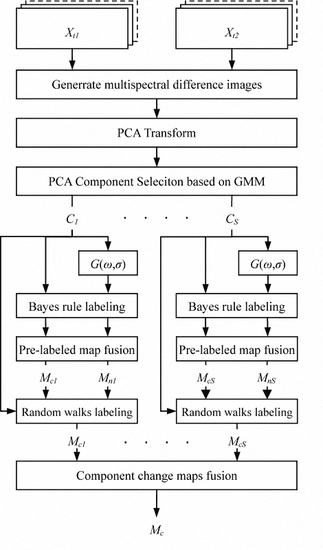Unsupervised Change Detection for Multispectral Remote Sensing Images Using Random Walks
Abstract
:1. Introduction
2. Random Walks on Graph
3. Proposed Unsupervised Change Detection
3.1. Enhancement of the Difference Image Using Adaptive PCA
- Step 1:
- Initialize the selection threshold t, .
- Step 2:
- Normalize as Equation (17) and sort in decreasing order:
- Step 3:
- If , then the corresponding component is the unique selected component.
- Step 4:
- Otherwise, repeatedly abandon the component with , until the sum of the rest is less than or equals to t. Then, the remaining components are selected for change detection.
3.2. Identification of Pre-Labeled Set Based on Bayes Rule
3.3. Generation of Change Map Based on Random Walks
- Step 1:
- Initialize the selected component and the pre-labeled map and .
- Step 2:
- Construct matrix L using Equation (1).
- Step 3:
- Solve Equation (8) to obtain the potentials for non-change label. The potential for change label can be derived by for computational efficiency.
- Step 4:
- Assign a label to each non-labeling pixel according to Equation (9).
4. Experiments
4.1. Data Sets
4.2. Parameter Setting
4.3. The Effect of the Adaptive PCA Approach
4.4. Comparisons with Other Change Detection Methods
- False-alarm rate ,where is the number of unchanged pixels classified as changed pixels, and is the total number of unchanged pixels.
- Missed-alarm rate ,where is the number of changed pixels classified as unchanged pixels, and is the total number of changed pixels.
- Error rate is the total number of wrongly classified pixels over the total number of pixels,
5. Conclusions
Acknowledgments
Author Contributions
Conflicts of Interest
Abbreviations
| MS | Multi-Spectral |
| SVM | Support Vector Machine PCA: Princpal Component Analysis |
| CVA | Change Vector Analysis |
| MRF | Markov Random Field |
| GMM | Gaussian Mixture Model |
| ASTER | Advanced Spaceborne Thermal Emission and Reflection Radiometer |
| VNIR | Visible and Near-Infrared |
| TM | Thematic Mapper |
| MLSK | multi-resolution level set method |
| BPCA | Block PCA |
| EM | Expectation Maximization |
| ICM | Iterated Conditional Models |
References
- Vittek, M.; Brink, A.; Donnay, F.; Simonetti, D.; Desclée, B. Land cover change monitoring using Landsat MSS/TM satellite image data over West Africa between 1975 and 1990. Remote Sens. 2014, 6, 658–676. [Google Scholar] [CrossRef]
- Krishnan, A.K.; Nissen, E.; Saripalli, S.; Arrowsmith, R.; Corona, A.H. Change detection using airborne LiDAR: Applications to earthquakes. In Experimental Robotics; Springer: Berlin/Heidelberg, Germany, 2013; pp. 733–743. [Google Scholar]
- Byun, Y.; Han, Y.; Chae, T. Image fusion-based change detection for flood extent extraction using bi-temporal very high-resolution satellite images. Remote Sens. 2015, 7, 10347–10363. [Google Scholar] [CrossRef]
- Mertes, C.M.; Schneider, A.; Sulla-Menashe, D.; Tatem, A.; Tan, B. Detecting change in urban areas at continental scales with MODIS data. Remote Sens. Environ. 2015, 158, 331–347. [Google Scholar] [CrossRef]
- Awrangjeb, M. Effective generation and update of a building map database through automatic building change detection from LiDAR point cloud data. Remote Sens. 2015, 7, 14119–14150. [Google Scholar] [CrossRef]
- Volpi, M.; Tuia, D.; Bovolo, F.; Kanevski, M.; Bruzzone, L. Supervised change detection in VHR images using contextual information and support vector machines. Int. J. Appl. Earth Obs. Geoinf. 2013, 20, 77–85. [Google Scholar] [CrossRef]
- Gao, F.; de Colstoun, E.B.; Ma, R.; Weng, Q.; Masek, J.G.; Chen, J.; Pan, Y.; Song, C. Mapping impervious surface expansion using medium-resolution satellite image time series: A case study in the Yangtze River Delta, China. Int. J. Remote Sens. 2012, 33, 7609–7628. [Google Scholar] [CrossRef]
- Wang, Q.; Shi, W.; Atkinson, P.M.; Li, Z. Land cover change detection at subpixel resolution with a Hopfield neural network. IEEE J. Sel. Top. Appl. Earth Obs. Remote Sens. 2015, 8, 1339–1352. [Google Scholar] [CrossRef]
- Lyu, H.; Lu, H.; Mou, L. Learning a transferable change rule from a recurrent neural network for land cover change detection. Remote Sens. 2016, 8, 506. [Google Scholar] [CrossRef]
- El-Kawy, O.A.; Rød, J.; Ismail, H.; Suliman, A. Land use and land cover change detection in the western Nile Delta of Egypt using remote sensing data. Appl. Geogr. 2011, 31, 483–494. [Google Scholar] [CrossRef]
- Sinha, P.; Kumar, L.; Reid, N. Rank-based methods for selection of landscape metrics for land cover pattern change detection. Remote Sens. 2016, 8, 107. [Google Scholar] [CrossRef]
- Singh, A. Review article digital change detection techniques using remotely-sensed data. Int. J. Remote Sens. 1989, 10, 989–1003. [Google Scholar] [CrossRef]
- Melgani, F.; Moser, G.; Serpico, S.B. Unsupervised change-detection methods for remote-sensing images. Opt. Eng. 2002, 41, 3288–3297. [Google Scholar]
- Celik, T.; Ma, K. Unsupervised change detection for satellite images using Dual-Tree complex wavelet transform. IEEE Trans. Geosci. Remote Sens. 2010, 48, 1199–1210. [Google Scholar] [CrossRef]
- Liu, S.; Bruzzone, L.; Bovolo, F.; Du, P. A novel sequential spectral change vector analysis for representing and detecting multiple changes in hyperspectral images. In Proceedings of the 2014 IEEE International Geoscience and Remote Sensing Symposium, Quebec City, QC, Canada, 13–18 July 2014; pp. 4656–4659. [Google Scholar]
- Zhuang, H.; Deng, K.; Fan, H.; Yu, M. Strategies combining spectral angle mapper and change vector analysis to unsupervised change detection in multispectral images. IEEE Geosci. Remote Sens. Lett. 2016, 13, 681–685. [Google Scholar] [CrossRef]
- Chen, Q.; Chen, Y. Multi-feature object-based change detection using self-adaptive weight change vector analysis. Remote Sens. 2016, 8, 549. [Google Scholar] [CrossRef]
- Rosin, P.L. Thresholding for change detection. Comput. Vis. Image Underst. 2002, 86, 79–95. [Google Scholar] [CrossRef]
- Sezgin, M.; Sankur, B. Survey over image thresholding techniques and quantitative performance evaluation. J. Electron. Imaging 2004, 13, 146–165. [Google Scholar]
- Kittler, J.; Illingworth, J. Minimum error thresholding. Pattern Recognit. 1986, 19, 41–47. [Google Scholar] [CrossRef]
- Bruzzone, L.; Prieto, D.F. Automatic analysis of the difference image for unsupervised change detection. IEEE Trans. Geosci. Remote Sens. 2000, 38, 1171–1182. [Google Scholar] [CrossRef]
- Melgani, F.; Bazi, Y. Markovian fusion approach to robust unsupervised change detection in remotely sensed imagery. IEEE Geosci. Remote Sens. Lett. 2006, 3, 457–461. [Google Scholar] [CrossRef]
- Bovolo, F.; Bruzzone, L.; Marconcini, M. A novel approach to unsupervised change detection based on a semisupervised SVM and a similarity measure. IEEE Trans. Geosci. Remote Sens. 2008, 46, 2070–2082. [Google Scholar] [CrossRef]
- Bazi, Y.; Melgani, F.; Al-Sharari, H. Unsupervised change detection in multispectral remotely sensed imagery with level set methods. IEEE Trans. Geosci. Remote Sens. 2010, 48, 3178–3187. [Google Scholar] [CrossRef]
- Grady, L. Random walks for image segmentation. IEEE Trans. Pattern Anal. Mach. Intell. 2006, 28, 1768–1783. [Google Scholar] [CrossRef] [PubMed]
- Celik, T. Unsupervised change detection in satellite images using principal component analysis and k-means clustering. IEEE Geosci. Remote Sens. Lett. 2009, 6, 772–776. [Google Scholar] [CrossRef]
- Diestel, R. Graph Theory, 4th ed.; Graduate Texts in Mathematics; Springer: Berlin/Heidelberg, Germany, 2010; Chapter 1; Volume 173. [Google Scholar]
- Boykov, Y.; Funka-Lea, G. Graph cuts and efficient N-D image segmentation. Int. J. Comput. Vis. 2006, 70, 109–131. [Google Scholar] [CrossRef]
- Doyle, P.G.; Snell, J.L. Random Walks and Electric Networks; The Mathematical Association of America: Washington, DC, USA, 1984. [Google Scholar]
- Grady, L.; Schwartz, E. Anisotropic Interpolation on Graphs: The Combinatorial Dirichlet Problem; Technical Report; Boston University Center for Adaptive Systems and Department of Cognitive and Neural Systems: Boston, MA, USA, 2003. [Google Scholar]
- Deng, J.S.; Wang, K.; Deng, Y.H.; Qi, G.J. PCA-based land-use change detection and analysis using multitemporal and multisensor satellite data. Int. J. Remote Sens. 2008, 29, 4823–4838. [Google Scholar] [CrossRef]
- Lu, D.; Mausel, P.; Brondízio, E.; Moran, E. Change detection techniques. Int. J. Remote Sens. 2004, 25, 2365–2401. [Google Scholar] [CrossRef]
- Malila, W.A. Change Vector Analysis—An Approach for Detecting Forest Changes with Landsat; Institute of Electrical and Electronics Engineers: Piscataway, NJ, USA, 1980; pp. 326–336. [Google Scholar]
- USGS. Southwest U.S. Change Detection Images: Reno and Lake Tahoe, Nevada. Available online: http://geochange.er.usgs.gov/sw/changes/natural/reno-tahoe/cuts.html (accessed on 21 May 2013).
- NASA. Feature Articles: Mountaintop Mining, West Virginia. Available online: http://earthobservatory. nasa.gov/Features/WorldOfChange/hobet.php (accessed on 15 April 2013).
- Liu, L.; Wang, Y.; Wang, Y.; Yu, H. Pan-sharpening using an adaptive linear model. In Proceedings of the International Conference on Pattern Recognition, Istanbul, Turkey, 23–26 August 2010; pp. 4512–4515. [Google Scholar]
- Inamdar, S.; Bovolo, F.; Bruzzone, L.; Chaudhuri, S. Multidimensional probability density function matching for preprocessing of multitemporal remote sensing images. IEEE Trans. Geosci. Remote Sens. 2008, 46, 1243–1252. [Google Scholar] [CrossRef]
- Besag, J. On the statistical analysis of dirty pictures. J. R. Stat. Soc. B 1986, 48, 48–259. [Google Scholar] [CrossRef]
- Chan, T.F.; Vese, L.A. Active contours without edges. IEEE Trans. Image Process. 2001, 10, 266–277. [Google Scholar] [CrossRef] [PubMed]
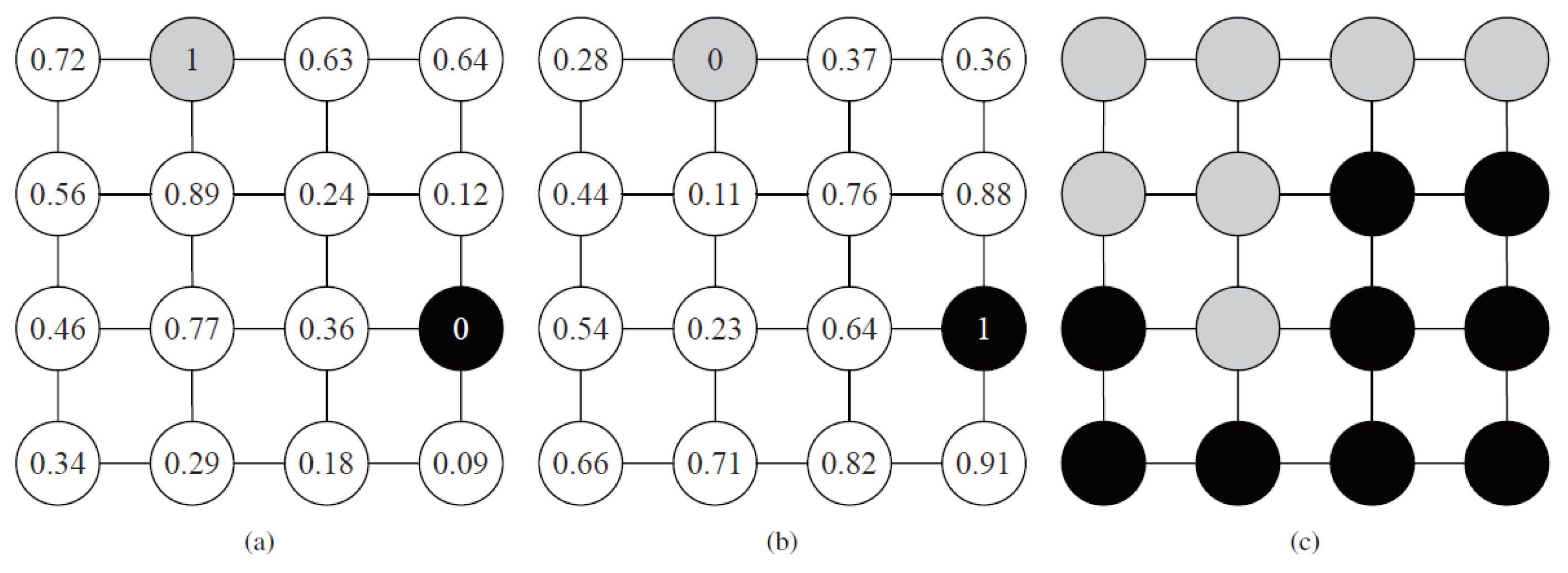
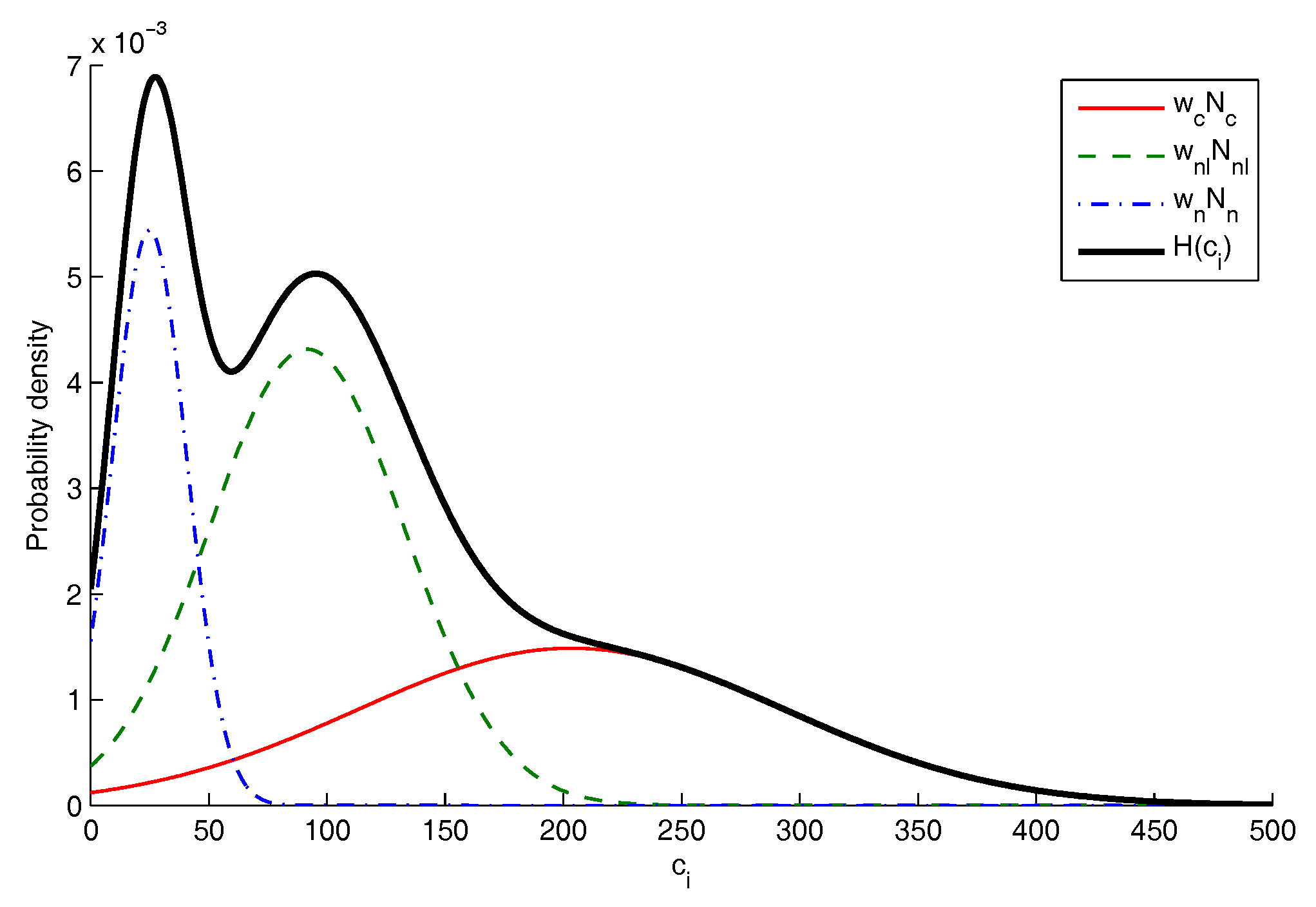
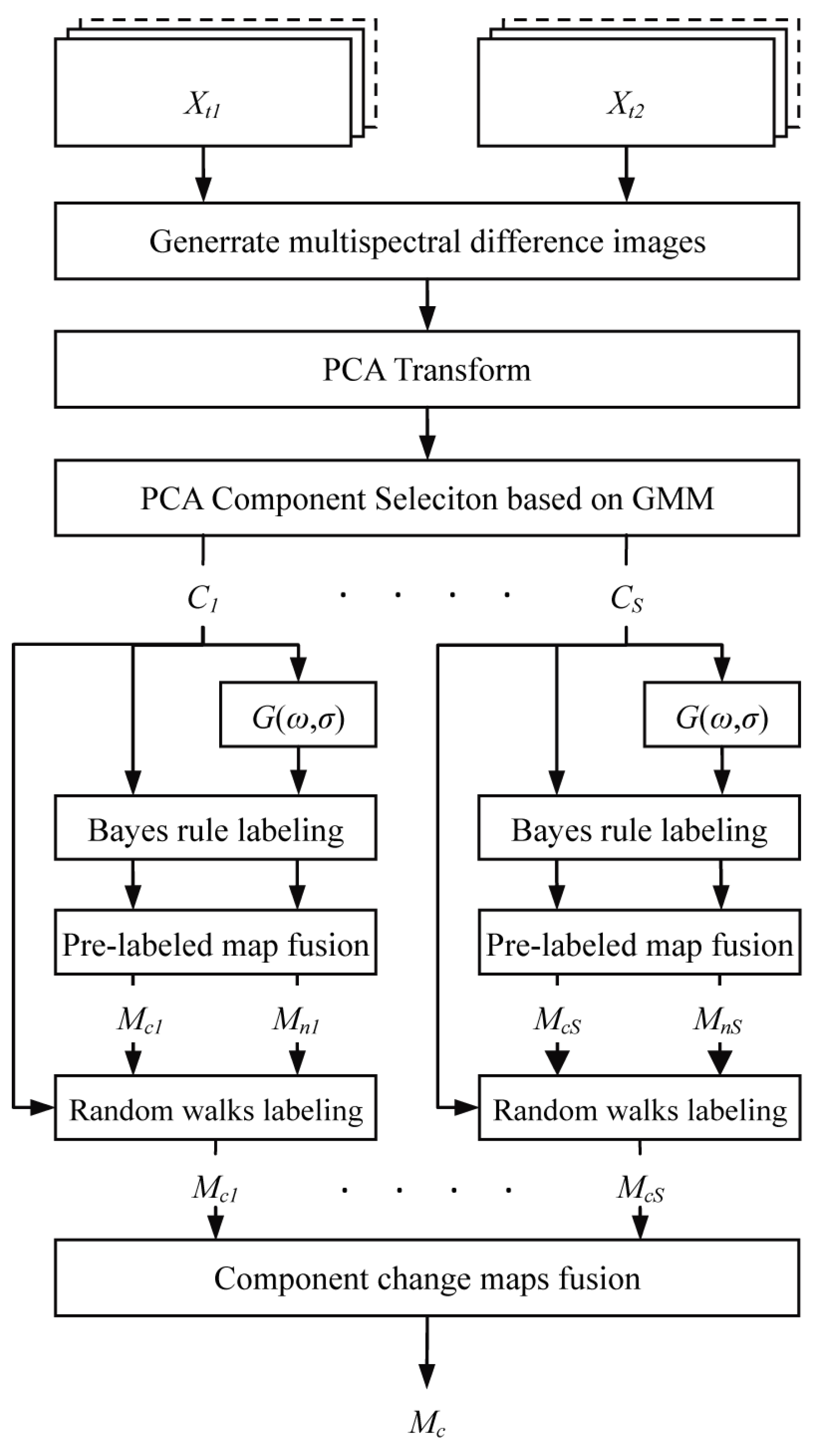

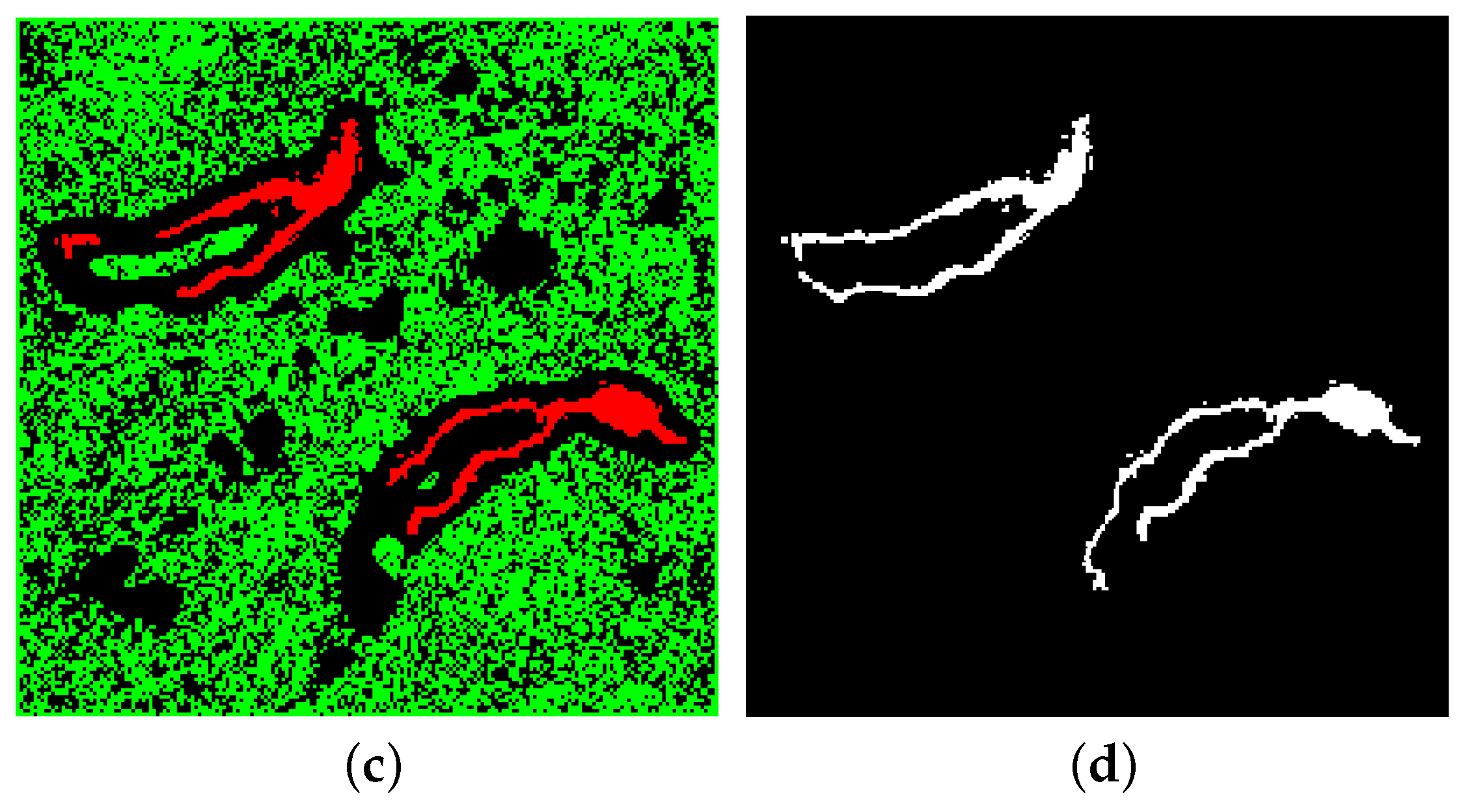
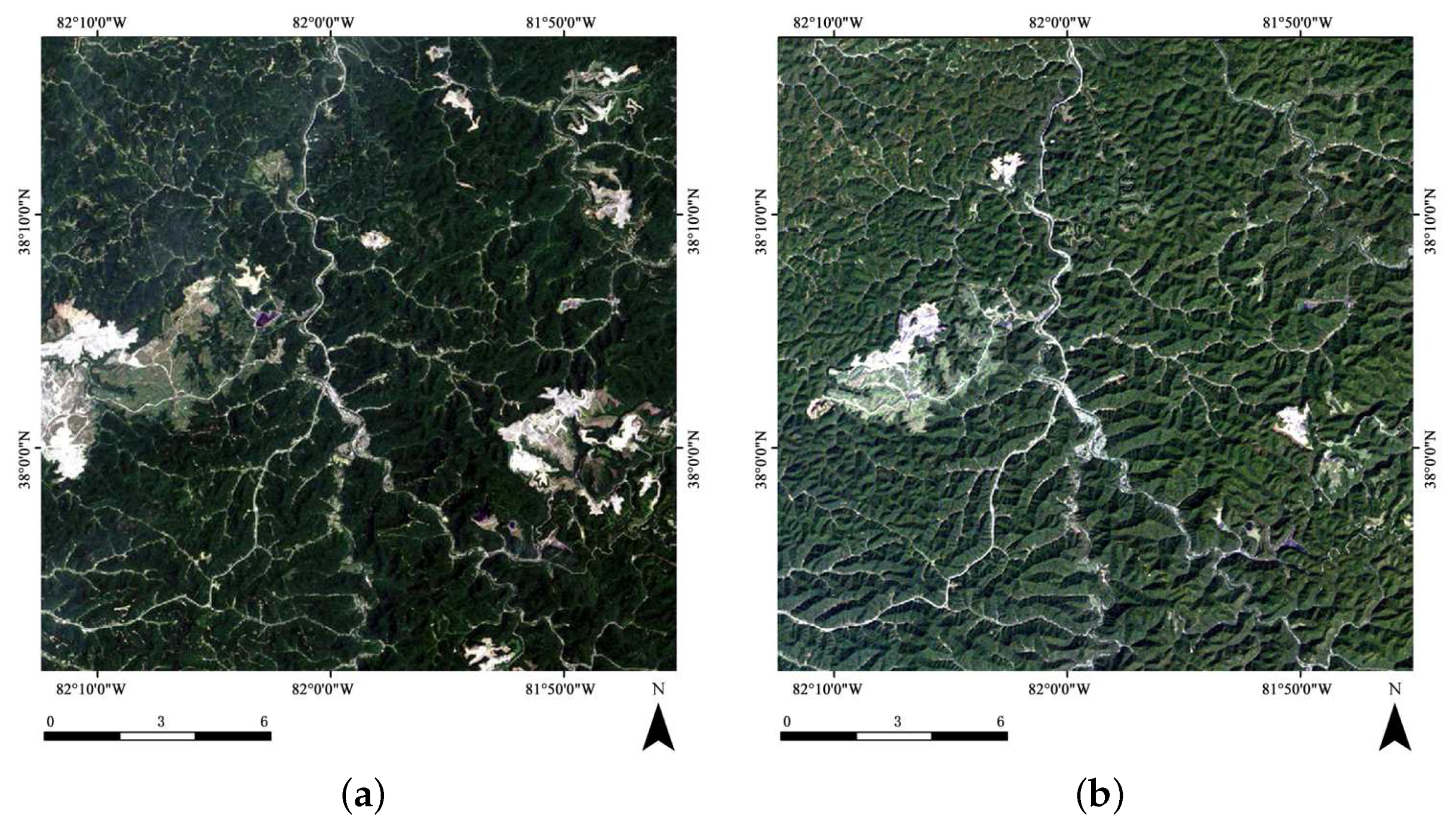
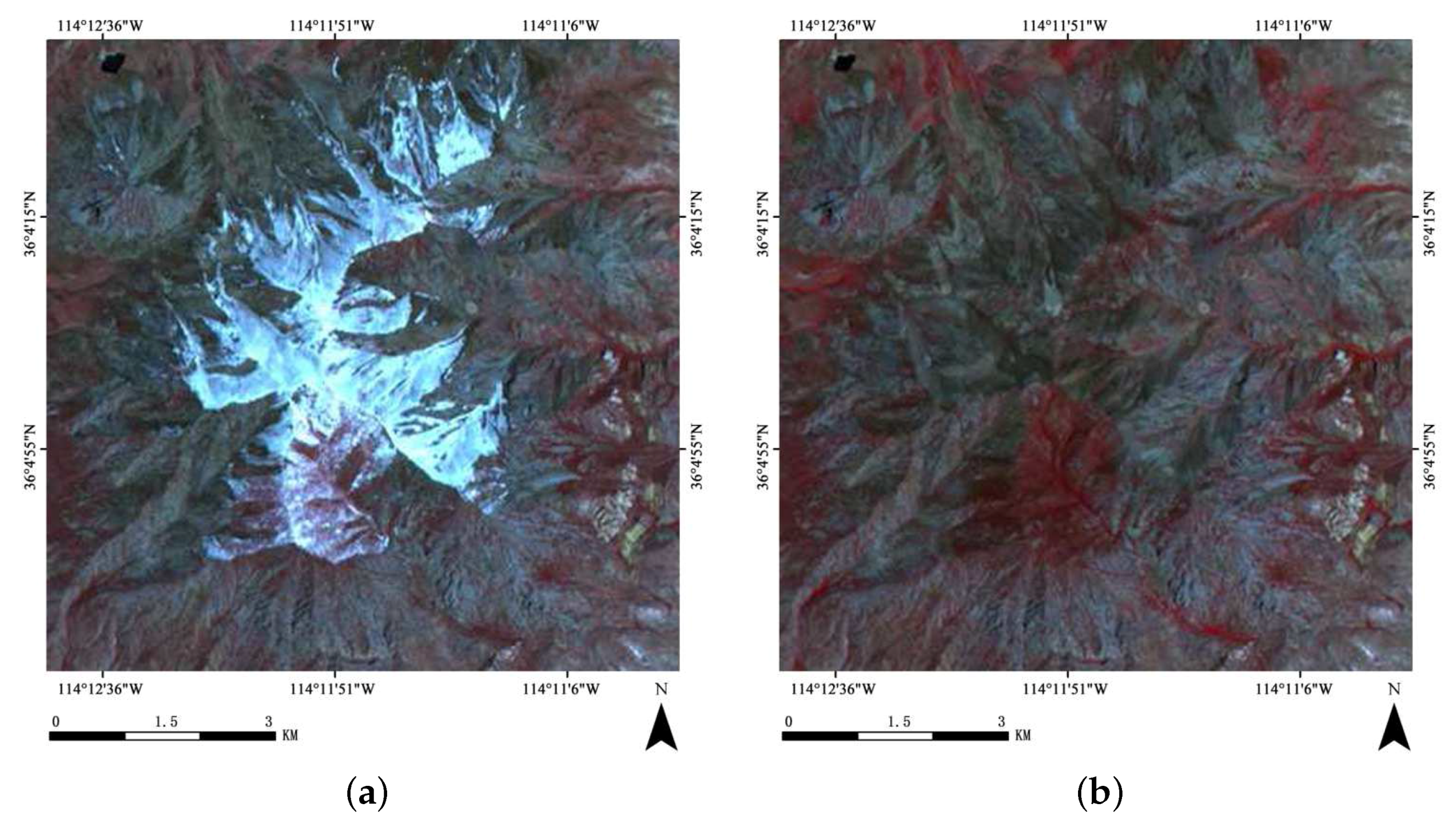
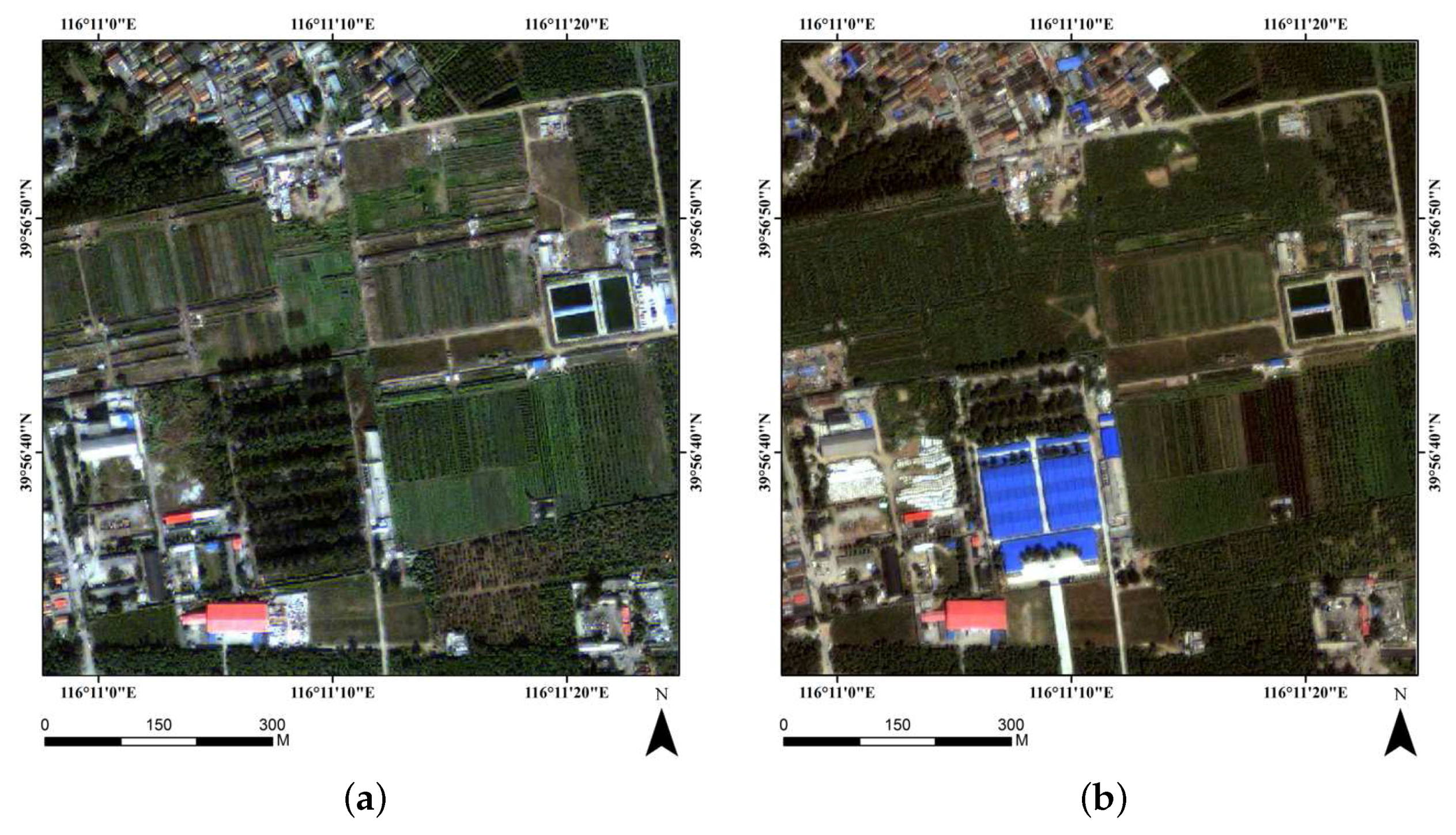
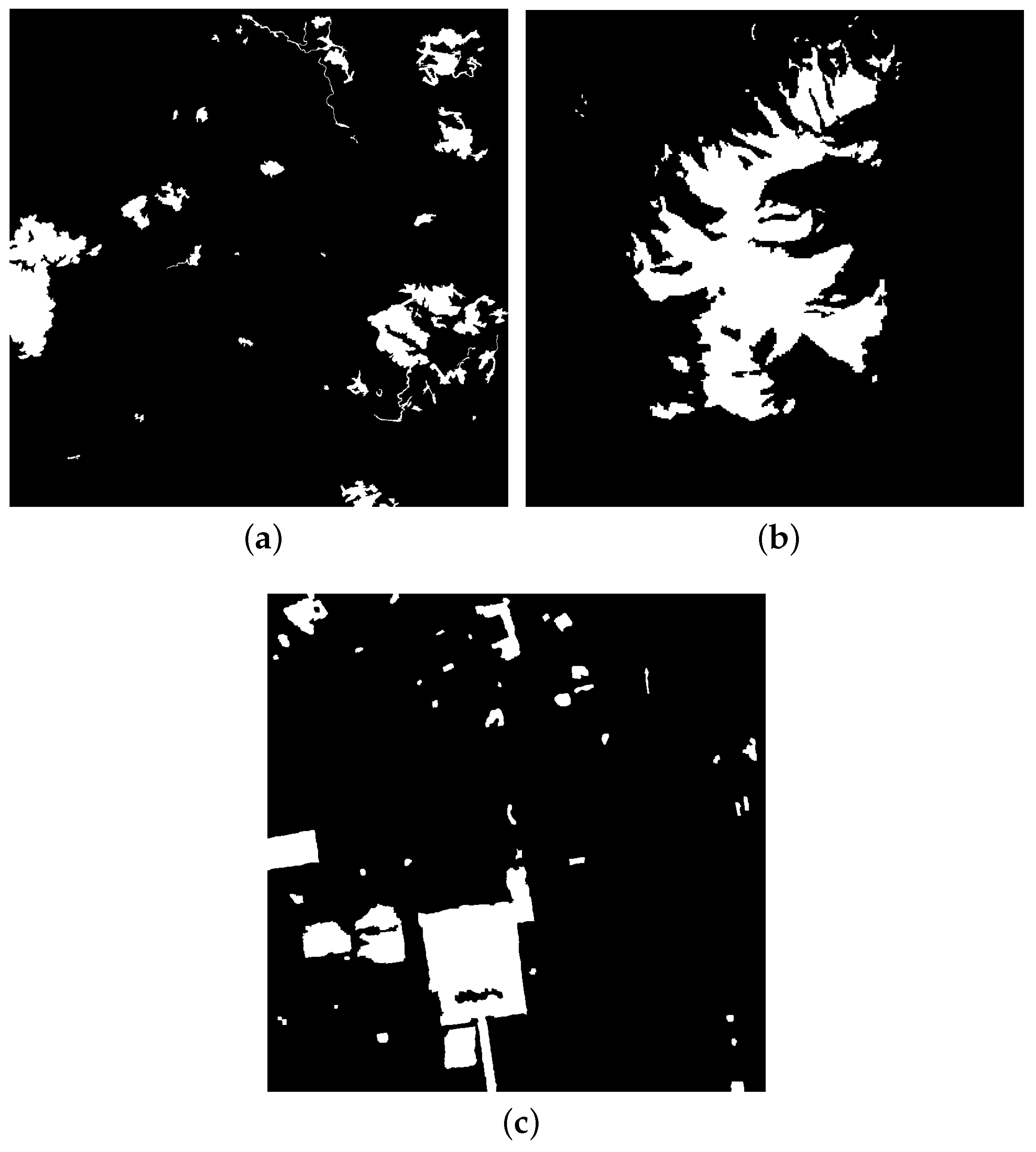

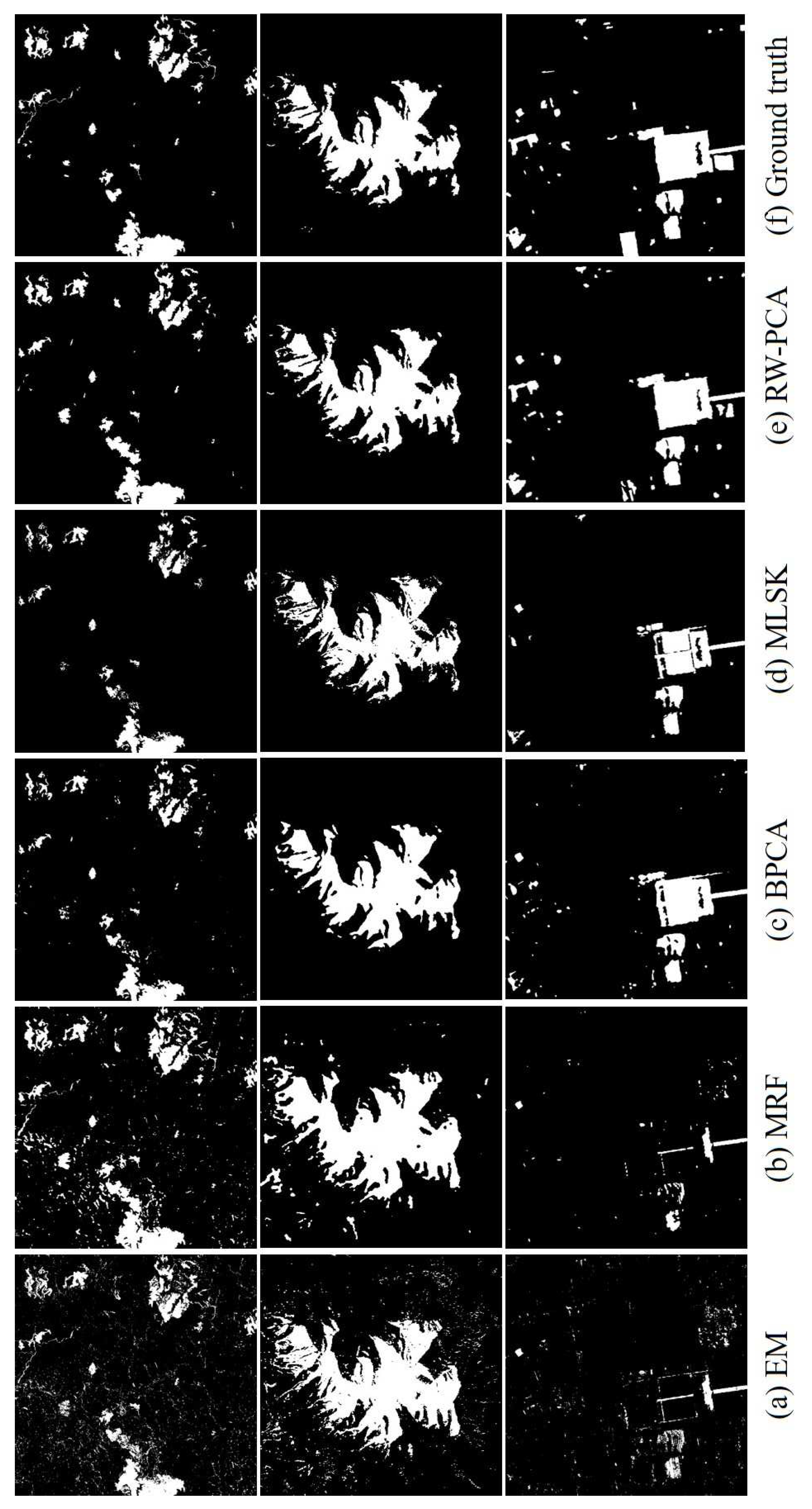
| Dataset | Selected Component | ||||
|---|---|---|---|---|---|
| ASTER | 0.9991 | 0.0004 | 0.0005 | - | 1 |
| TM | 0.7291 | 0.1389 | 0.1320 | - | 1 |
| Quickbird | 0.0888 | 0.2375 | 0.5449 | 0.1288 | 2, 3 |
| Method | Hobet (TM) | Mountain (ASTER) | Shijingshan (QuickBird) | ||||||
|---|---|---|---|---|---|---|---|---|---|
| EM | 0.0346 | 0.0281 | 0.1181 | 0.0639 | 0.0741 | 0.0047 | 0.0809 | 0.0102 | 0.8051 |
| MRF | 0.0325 | 0.0323 | 0.0350 | 0.0626 | 0.0730 | 0.0046 | 0.0771 | 0.0021 | 0.8442 |
| BPCA | 0.0227 | 0.0020 | 0.2848 | 0.0196 | 0.0212 | 0.0098 | 0.0338 | 0.0061 | 0.3172 |
| MLSK | 0.0265 | 0.0004 | 0.3952 | 0.0165 | 0.0109 | 0.0493 | 0.0367 | 0.0008 | 0.4046 |
| PCA-RW | 0.0098 | 0.0035 | 0.0904 | 0.0137 | 0.0155 | 0.0031 | 0.0179 | 0.0070 | 0.1305 |
© 2017 by the authors. Licensee MDPI, Basel, Switzerland. This article is an open access article distributed under the terms and conditions of the Creative Commons Attribution (CC BY) license (http://creativecommons.org/licenses/by/4.0/).
Share and Cite
Liu, Q.; Liu, L.; Wang, Y. Unsupervised Change Detection for Multispectral Remote Sensing Images Using Random Walks. Remote Sens. 2017, 9, 438. https://doi.org/10.3390/rs9050438
Liu Q, Liu L, Wang Y. Unsupervised Change Detection for Multispectral Remote Sensing Images Using Random Walks. Remote Sensing. 2017; 9(5):438. https://doi.org/10.3390/rs9050438
Chicago/Turabian StyleLiu, Qingjie, Lining Liu, and Yunhong Wang. 2017. "Unsupervised Change Detection for Multispectral Remote Sensing Images Using Random Walks" Remote Sensing 9, no. 5: 438. https://doi.org/10.3390/rs9050438




